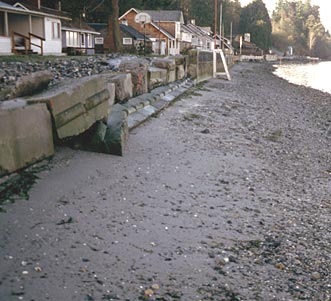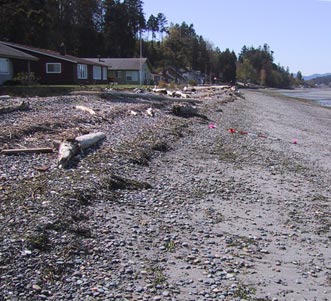Seawalls may affect abundance of prey for shorebirds, salmon
 Marine
Marine A new study in Puget Sound, Washington, suggests that building seawalls and other shoreline structures may reduce the diversity and abundance of some intertidal invertebrates and coastal insects. Because these creatures are food for salmon, shorebirds, and other wildlife, shoreline armoring might indirectly alter the broader ecosystem.
For many years, scientists have known that armoring the shoreline against erosion often causes more headaches than it solves, such as speeding up the erosion of nearby beaches. Little has been known, however, about how shoreline armoring affects animal and plant species that live near the water’s edge.
Kathryn Sobocinski and two colleagues from the University of Washington began to investigate this question in a study published last month in Estuaries and Coasts. According to the authors,
“Approximately one third of the Puget Sound, Washington, shoreline is anthropogenically modified, with over 70% modified in and around the greater Seattle metropolitan area, resulting in significant shoreline and intertidal beach disruption from the installation of piers, docks, shoreline revetments, and ports. Despite rapid growth, there has been little focus on beach ecosystem alteration and the resulting biological impacts of shoreline development.”
 At 4 locations in central Puget Sound, the scientists measured differences between natural beaches and adjacent altered beaches in organic debris, sediment grain size, intertidal marine invertebrates, and shoreline insects. The altered sites had seawalls and other structures that extended into the intertidal zone, replacing the upper beach habitat with steep or vertical hard surfaces.
At 4 locations in central Puget Sound, the scientists measured differences between natural beaches and adjacent altered beaches in organic debris, sediment grain size, intertidal marine invertebrates, and shoreline insects. The altered sites had seawalls and other structures that extended into the intertidal zone, replacing the upper beach habitat with steep or vertical hard surfaces.
The researchers found that seaweed wrack, beach hoppers, and insects were more abundant at natural beaches, while crustaceans were more numerous at altered sites. There are a few possible explanations for this observed difference.
 (Top) Shoreline seawall near Anacortes, WA. (Bottom) Same site after removal of armoring. Credit, Coastal Geological Services.Altered sites had coarser sediments, which may have influenced the types of invertebrates. Also, vertical surfaces prevented buildup of seaweed wrack, largely eliminating the invertebrates normally found in wrack. From a conservation standpoint, the lack of organic debris is notable because many shorebirds, crabs, small mammals, and beetles feed on beach hoppers and other creatures associated with wrack.
(Top) Shoreline seawall near Anacortes, WA. (Bottom) Same site after removal of armoring. Credit, Coastal Geological Services.Altered sites had coarser sediments, which may have influenced the types of invertebrates. Also, vertical surfaces prevented buildup of seaweed wrack, largely eliminating the invertebrates normally found in wrack. From a conservation standpoint, the lack of organic debris is notable because many shorebirds, crabs, small mammals, and beetles feed on beach hoppers and other creatures associated with wrack.
However, limitations of the sampling methods are likely responsible for some the observed differences in the invertebrate community. In particular, the natural beaches were sampled along the wrack line, while altered sites were sampled—out of necessity—at a lower elevation in the intertidal zone. One would expect a different mix of invertebrate species between these two elevations, regardless of whether a shoreline structure was present.
To complement the 4 sites with paired natural and altered beaches, Sobocinski and her colleagues also studied 26 other shoreline sites (10 natural, 16 altered) scattered around Puget Sound. These natural and armored shores displayed smaller differences in invertebrate species, apparently because the structures at these altered sites were at higher elevations and did not extend so much into the water.
While recognizing the limitations of their study methods, the scientists conclude,
“where shoreline armoring lowers the land–sea interface, benthic infauna and insect assemblages are disrupted. Widespread shoreline modifications may decrease the availability of prey resources for fish and wildlife and decrease the contribution of organic material entering the nearshore ecosystem.”
--Reviewed by Peter Taylor
Sobocinski, K., Cordell, J., & Simenstad, C. (2010). Effects of Shoreline Modifications on Supratidal Macroinvertebrate Fauna on Puget Sound, Washington Beaches Estuaries and Coasts DOI: 10.1007/s12237-009-9262-9




Reader Comments